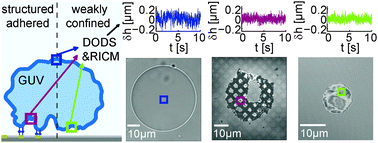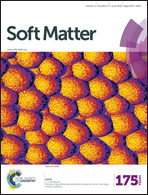Nanometric thermal fluctuations of weakly confined biomembranes measured with microsecond time-resolution
Abstract
We probe the bending fluctuations of bio-membranes using highly deflated giant unilamellar vesicles (GUVs) bound to a substrate by a weak potential arising from generic interactions. The substrate is either homogeneous, with GUVs bound only by the weak potential, or is chemically functionalized with a micro-pattern of very strong specific binders. In both cases, the weakly adhered membrane is seen to be confined at a well-defined distance above the surface while it continues to fluctuate strongly. We quantify the fluctuations of the weakly confined membrane at the substrate proximal surface as well as of the free membrane at the distal surface of the same GUV. This strategy enables us to probe in detail the damping of fluctuations in the presence of the substrate, and to independently measure the membrane tension and the strength of the generic interaction potential. Measurements were done using two complementary techniques – dynamic optical displacement spectroscopy (DODS, resolution: 20 nm, 10 μs), and dual wavelength reflection interference contrast microscopy (DW-RICM, resolution: 4 nm, 50 ms). After accounting for the spatio-temporal resolution of the techniques, an excellent agreement between the two measurements was obtained. For both weakly confined systems we explore in detail the link between fluctuations on the one hand and membrane tension and the interaction potential on the other hand.



 Please wait while we load your content...
Please wait while we load your content...